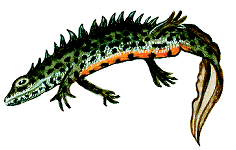Newts
 Newts are sometimes confused with lizards, but they are definitely not these reptiles because they have no scales, only thin, damp skin through which they can breathe, and they move much more slowly. Also lizards, like all reptiles, do not breed in water. There are three species of newts found in Britain - all native. These are the common or smooth newt, the palmate newt and the great crested newt.
Newts are sometimes confused with lizards, but they are definitely not these reptiles because they have no scales, only thin, damp skin through which they can breathe, and they move much more slowly. Also lizards, like all reptiles, do not breed in water. There are three species of newts found in Britain - all native. These are the common or smooth newt, the palmate newt and the great crested newt.
Common newt (Triturus vulgaris): also known as the smooth newt, this newt is the most widespread of the three species, found mainly in lowland habitats. It is the only newt found in Ireland. It has a soft, smooth skin and a long tail, flattened at the sides. From head to the tip of the tail, the common newt measures about 10cm (4in.). Normally, it is a yellow- olive colour, but in the breeding season the male becomes much brighter, with an orange underside and spotted throat and belly. He also grows a crest down his back and tail.
Common newts spend summer, autumn and winter on land in habitats such as open woodland, lush pasture and gardens, not far from their breeding ponds. During the day they hide under logs or stones or in thick grass. They come out on damp nights to hunt for their food. Like all newts, common newts eat a wide variety of prey, which they grab greedily and swallow whole. Their diet includes snails, slugs, worms, insects - and other newts!
In winter, all newts hibernate, usually under logs, or stones, never far from water. In early spring, about March or April, common newts move to their breeding ponds - they prefer fairly deep ponds - to mate and lay their eggs. Unlike frogs and toads, they do not lay eggs in masses or strings, but the female wraps each egg separately in the folds of a water plant leaf. This helps to protect the egg from predators.
A female newt lays about 300 eggs, so the egg-laying process takes her many hours. Newt tadpoles look like tiny dragons with feathery gills. They develop front legs about two weeks after hatching, and the hind legs grow soon after. They feed on tiny water creatures such as water fleas and worms, and even prey on smaller newt tadpoles. At the end of the summer the fully formed, tiny newts leave the water to live on the land. When they are two years old, they return to the water to breed. Only about six out of every 300 will manage to reach maturity - most of them fall prey to predators such as grass snakes, rats, blackbirds and hedgehogs.
Palmate newt (Triturus helveticus): this newt is the smallest British newt, about 7.5cm (3in.) in length, and is mainly found in heathland or upland habitats.
The palmate newt is similar in colour to the common newt, but in the breeding season the male palmate develops black webs on his hind feet, a short filament at the end of the tail and his underside is plain rather than spotted. It is difficult to tell the females of the two species apart.
Great crested newt (Triturus cristatus): this is the largest British newt, about 16cm (6.5in.) and is also known as the warty newt. It is now very rare, found only in a few areas of lowland England, mainly the south and east. It is even more rarely found in Scotland and Wales.
The skin of the great crested newt is not as smooth as that of the other two species; it is warty (bumpy) and almost black in colour, with a black-spotted golden underside. In the breeding season the male grows a high, toothed crest along his back and tail and silver streaks on his tail. Like the other newts, the male waves his tail and crest during courtship to attract and impress the females.
Read More: Protection of Amphibians